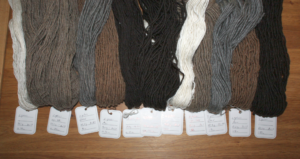Search the Blog
Latest Comments
Harma
Blog Break .
29 April 2024
Isn't the selvedge something to worry about in a later stage? It seems to me a lot more important th...
Beatrix
Experiment!
23 April 2024
The video doesn´t work (at least for me). If I click on "activate" or the play-button it just disapp...
Katrin
Spinning Speed Ponderings, Part I.
15 April 2024
As far as I know, some fabrics do get washed before they are sold, and some might not be. But I can'...
Kareina
Spinning Speed Ponderings, Part I.
15 April 2024
I have seen you say few times that "no textile ever is finished before it's been wet and dried again...
Katrin
How on earth did they do it?
27 March 2024
Ah, that's good to know! I might have a look around just out of curiosity.
I've since learned that w...
Density Differences.
Let's get back to some more textile-related things, shall we?
Test spinning has finished, and now... more testing is about to happen: I'll set up the warp for an Egtved corded skirt, and I'm all excited about that!
Before I get to warping, though, you're getting a shot of the test yarns, all nicely set up in a row:

I did some labeling, and weighing, and measuring, of course. Just like I expected, even though I tried to spin all of them about the same thickness and the same amount of twist, there are considerable differences between the individual fibres. The Nm, for instance, varies between 0.8 and 1.9.
If you're not familiar with Nm, that is a gauge measurement for yarn thicknesses, and it tells you how many metres per gram a yarn has. So Nm 1 would be a single yarn with one metre per gram; Nm 5 would be a single with 5 metres per gram. If you have two numbers, like in Nm 10/2, the second one gives the amount of yarns in the ply, and the first the overall count - so the Nm 10/2 would be a two-ply yarn with ten metres per gram, made up from two singles. (In most yarns, you can assume that the single yarns in the plied yarn will be similar, so that would mean they both are an Nm 10, and the plied yarn thus ends up being Nm 5.)
In my test spins, the Gotland yarn has the lowest Nm, with 0.8; it's also the fibre that is densest when I portion tops for sale, and thus makes the smallest 100-g ball. The others were more or less similar, ranging from Nm 1,3 to 1,9 - with the irregularities of hand-spinning, and the squish factor when skeining (the tension, and half a round more or less), and the relatively small sample size, that, to me, does not look like such a significant difference than between Gotland and the others. More spinning will come, though, and maybe then something more reliable will show up.
First, though... off to warp!
(edit to fix typo!)
Test spinning has finished, and now... more testing is about to happen: I'll set up the warp for an Egtved corded skirt, and I'm all excited about that!
Before I get to warping, though, you're getting a shot of the test yarns, all nicely set up in a row:

I did some labeling, and weighing, and measuring, of course. Just like I expected, even though I tried to spin all of them about the same thickness and the same amount of twist, there are considerable differences between the individual fibres. The Nm, for instance, varies between 0.8 and 1.9.
If you're not familiar with Nm, that is a gauge measurement for yarn thicknesses, and it tells you how many metres per gram a yarn has. So Nm 1 would be a single yarn with one metre per gram; Nm 5 would be a single with 5 metres per gram. If you have two numbers, like in Nm 10/2, the second one gives the amount of yarns in the ply, and the first the overall count - so the Nm 10/2 would be a two-ply yarn with ten metres per gram, made up from two singles. (In most yarns, you can assume that the single yarns in the plied yarn will be similar, so that would mean they both are an Nm 10, and the plied yarn thus ends up being Nm 5.)
In my test spins, the Gotland yarn has the lowest Nm, with 0.8; it's also the fibre that is densest when I portion tops for sale, and thus makes the smallest 100-g ball. The others were more or less similar, ranging from Nm 1,3 to 1,9 - with the irregularities of hand-spinning, and the squish factor when skeining (the tension, and half a round more or less), and the relatively small sample size, that, to me, does not look like such a significant difference than between Gotland and the others. More spinning will come, though, and maybe then something more reliable will show up.
First, though... off to warp!
(edit to fix typo!)



